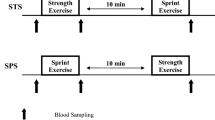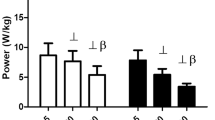Summary
Acute neuromuscular and endocrine adaptations to weight-lifting were investigated during two successive high intensity training sessions in the same day. Both the morning (I) (from 9.00 to 11.00 hours) and the afternoon (II) (from 15.00 hours to 17.00 hours) training sessions resulted in decreases in maximal isometric strength (p<0.01 and <0.05), shifts (worsening) in the force-time curve in the absolute scale (p<0.05 and ns.) and in decreases in the maximal integrated EMG (p<0.01 and <0.05) of the selected leg extensor muscles. Increases in serum total (p<0.05) and free testosterone (p<0.01) and in cortisol (p<0.01) concentrations were found during training session II. These were followed by decreases (p<0.001 andp<0.01 and ns.) in the levels of these hormones one hour after the termination of the session. The responses during the morning training session were different with regard to the decreases in serum total testosterone (p<0.05), free testosterone (ns.) and cortisol (p<0.05). Only slight changes were observed in the levels of luteinizing hormone and sex hormone-binding globulin during the training sessions. Increases (p<0.01) took place in somatotropin during both training sessions. The present findings suggest that high intensity strengthening exercises may result in acute adaptive responses in both the neuromuscular and endocrine systems. The diurnal variations may, however, partly mask the exercise-induced acute endocrinological adaptations in the morning. Recording of muscle activation and muscle strength and analysis of certain serum hormone concentrations with sufficient frequency during the training process may be useful in optimizing and controlling the contents of individual training sessions and the full training program.
Similar content being viewed by others
References
Aakvaag A, Sand T, Opstad PK, Fonnum F (1978) Hormonal changes in serum in young men during prolonged physical strain. Eur J Appl Physiol 39:283–291
Alén M, Reinilä M, Vihko R (1985) Response of serum hormones to androgen administration in power athletes. Med Sci Sports 17:354–359
Anderson DC (1974) Sex-hormone binding globulin. Clin Endocrinol 3:69–96
Branderberger G (1985) Cortisol responses to exercise and their interactions with diurnal secretory peaks. Exerc Endocrinol (eds) Fotherby K & Pal SB, pp 47–64
Brandenberger G, Follenius M, Hietter B (1982) Feedback from meal-related peaks determines diurnal changes in cortisol response to exercise. J Clin Endocrinol Metab 54:592
Clair P, Claustrat B, Jordan D, Dechaud H, Sassolas G (1985) Daily variations of plasma sex hormone-binding globulin binding capacity, testosterone and luteinizing hormone concentrations in healthy rested adult males. Hormone Res 21:220–223
Cumming DC, Brunsting LA, III, Strich G, Ries AL, Rebar RW (1986) Reproductive hormone increases in response to acute exercise in men. Med Sci Sports Exerc, vol 18, no 4, pp 369–373
Dessypris A, Kuoppasalmi K, Aldercreutz H (1976) Plasma cortisol, testosterone, androstenedione and luteinizing hormone (LH) in a non-competitive marathon run. J Steroid Biochem vol 7, pp 33–37
Doumas BT (1975) Standards for total serum protein assays — a collaborative study. Clin Chem 21:1159–1166
Follenius M, Brandenberger G (1986) Plasma free cortisol during secretory episodes. J Clin Endocrinol Metab 62:609
Galbo H, Hummer L, Petersen IB, Christensen NJ, Bie N (1977) Thyroid and testicular hormone responses to graded and prolonged exercise in man. Eur J Appl Physiol 36:101–106
Guezennec Y, Leger L, Lhoste F, Aymonod M, Pesquies PC (1986) Hormone and metabolite response to weight-lifting training sessions. Int J Sports Med 7:100–105
Häkkinen K, Komi PV (1986) Effects of fatigue and recovery on electromyographic and isometric force- and relaxation-time characteristics of human skeletal muscle. Eur J Appl Physiol 55:588–596
Häkkinen K, Komi PV (1983a) Electromyographic and mechanical characteristics of human skeletal muscle during fatigue under voluntary and reflex conditions. Electroenceph Clin Neurophysiol 55:436–444
Häkkinen K, Komi PV (1983b) Electromyographic changes during strength training and detraining. Med Sci Sports Exerc 15:455–460
Häkkinen K, Pakarinen A, Alén M, Kauhanen H, Komi PV (1987) Relationships between training volume, physical performance capacity and serum hormone concentrations during prolonged training in elite weightlifters. Int J Sports Med [Suppl] 8:61–65
Häkkinen K, Viitasalo JT, Komi PV (1980) Die Wirkung unterschiedlich kombinierter konzentrischer und exzentrischer Muskelarbeit auf Kraft-Zeit-Merkmale der Beinstreckmuskulatur. Leistungssport 10:374–381
Karagiorgos A, Garcia J, Brooks G (1979) Growth hormone response to continuous and intermittent exercise. Med Sci Sports Exerc 11:302–307
Komi PV (1973) A new electromechanical ergometer. In: Hauser G, Mellerowicz H (eds) 3. Internationales Seminar für Ergometrie. Ergon-Verlag, Berlin, pp 173–176
Komi PV, Rusko H (1974) Quantitative evaluation of mechanical and electrical changes during fatigue loading of eccentric and concentric work. Scand J Rehab Med [Suppl] 3:121–126
Komi PV, Viitasalo JT (1977) Changes in motor unit activity and metabolism in human skeletal muscle during and after repeated eccentric and concentric contractions. Acta Physiol Scand 100:246–254
Komi PV, Tesch P (1979) EMG frequency spectrum, muscle structure and fatigue during dynamic contractions in man. Eur J Appl Physiol 42:41–52
Kroll W, Clarkson P, Kamen G, Lambert J (1980) Muscle fibre type composition and knee extension isometric strength fatigue patterns in power- and endurance-trained males. Res Quart Exc Sport 51:323–333
Kuoppasalmi K, Näveri H, Kosunen K, Härkönen M, Adlercreutz H (1981) Plasma steroid levels in muscular exercise. In: Poortmans J (ed) International series on sport sciences, volume 11B. Biochem of exercise IV-B. G. Niset. University Park Press, Baltimore pp 149–160
Nilsson J, Tesch P, Thorstensson A (1977) Fatigue and EMG of repeated fast voluntary contractions in man. Acta Physiol Scand 101:194–198
Remes K, Kuoppasalmi K, Adlercreutz H (1985) Effect of physical exercise and sleep deprivation on plasma androgen levels: Modifying effect of physical fitness. Int J Sports Med 6:131–135
Thorstensson A, Karsson J (1976) Fatiguability and fibre composition of human skeletal muscle. Acta Physiol Scand 98:318–322
Vanhelder WP, Radomski MW, Goode RC (1984) Growth hormone responses during intermittent weight lifting exercise in men. Eur J Appl Physiol 53:31–34
Vanhelder W, Case W, Goode R, Radomski W (1986) Growth hormone regulation in two types of aerobic exercise of equal oxygen uptake. Eur J Appl Physiol 55:236–239
Viitasalo J (1983) Function of the knee extensor muscles during fatigue. In: Matsui H, Kobayashi K (eds) Biomechanics VIII A, Human Kinetics Publishers, Champaign IL, pp 271–277
Viitasalo J, Komi PV (1978a) Force-time characteristics and fiber composition in human leg extensor muscles. Eur J Appl Physiol 40:7–15
Viitasalo J, Komi PV (1978b) Isometric endurance, EMG power spectrum, and fiber composition in human quadriceps muscle. In: Asmussen E, Jörgensen K (eds) Biomechanics VI-A. University Park Press, Baltimore, pp 244–250
Viitasalo J, Komi PV (1980) EMG, reflex and reaction time components, muscle structure and fatigue during intermittent isometric contractions in man. Int J Sports Med 1:185–190
Viitsasalo J, Komi PV (1981) Effects of fatigue on isometric force- and relaxation-time characteristics in human muscle. Acta Physiol Scand 111:87–95
Viitasalo J, Saukkonen S, Komi PV (1980) Reproducibility of measurements of selected neuromuscular performance variables in man. Electromyogr Clin Neurophysiol 20:487–501
Author information
Authors and Affiliations
Rights and permissions
About this article
Cite this article
Häkkinen, K., Pakarinen, A., Alén, M. et al. Neuromuscular and hormonal responses in elite athletes to two successive strength training sessions in one day. Europ. J. Appl. Physiol. 57, 133–139 (1988). https://doi.org/10.1007/BF00640652
Accepted:
Issue Date:
DOI: https://doi.org/10.1007/BF00640652




